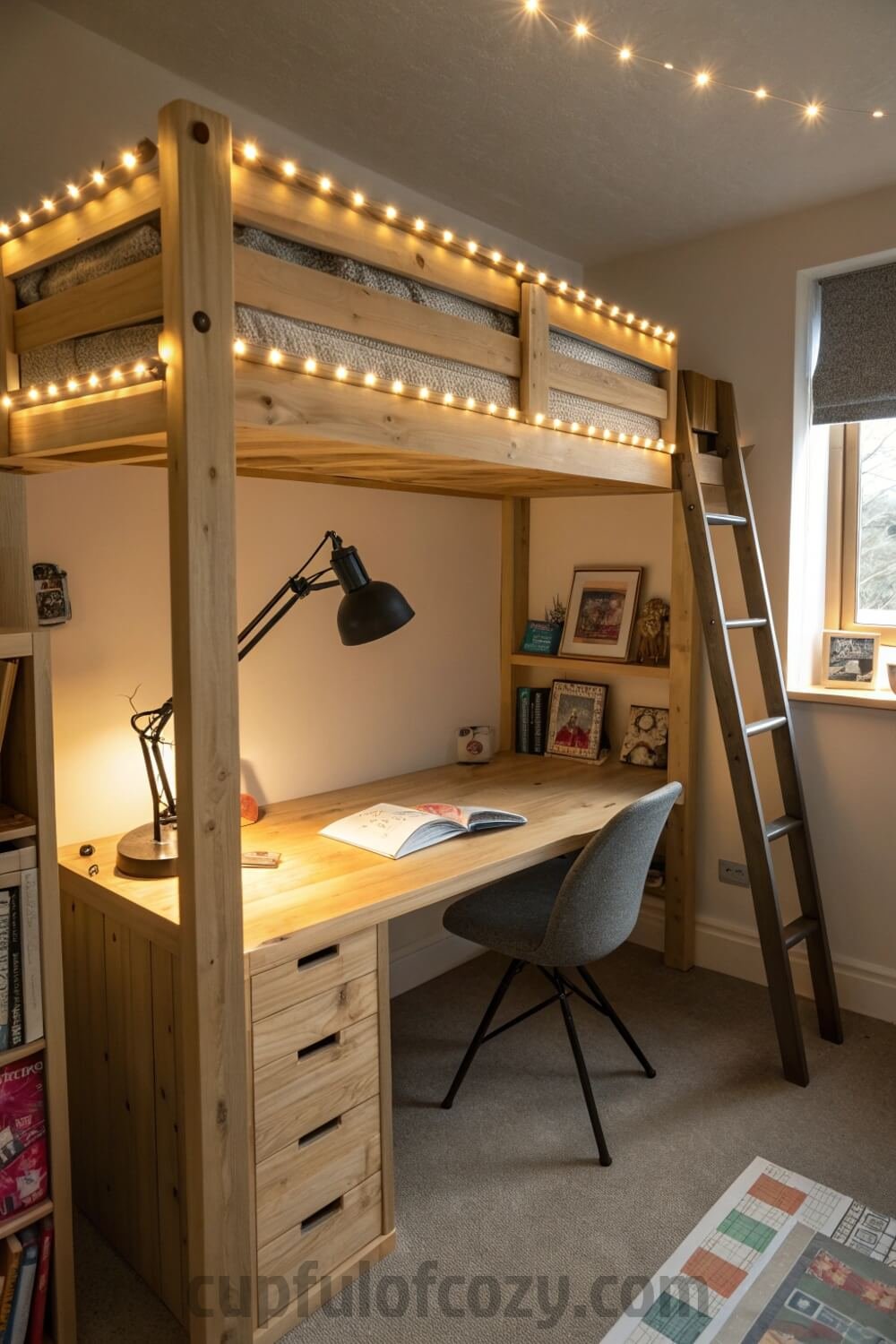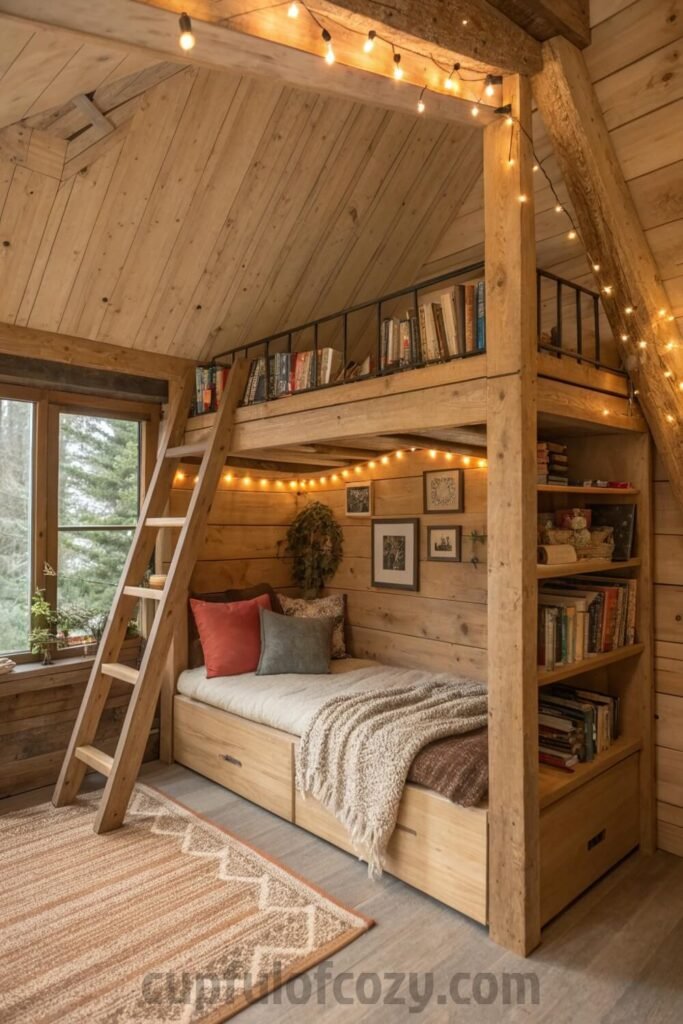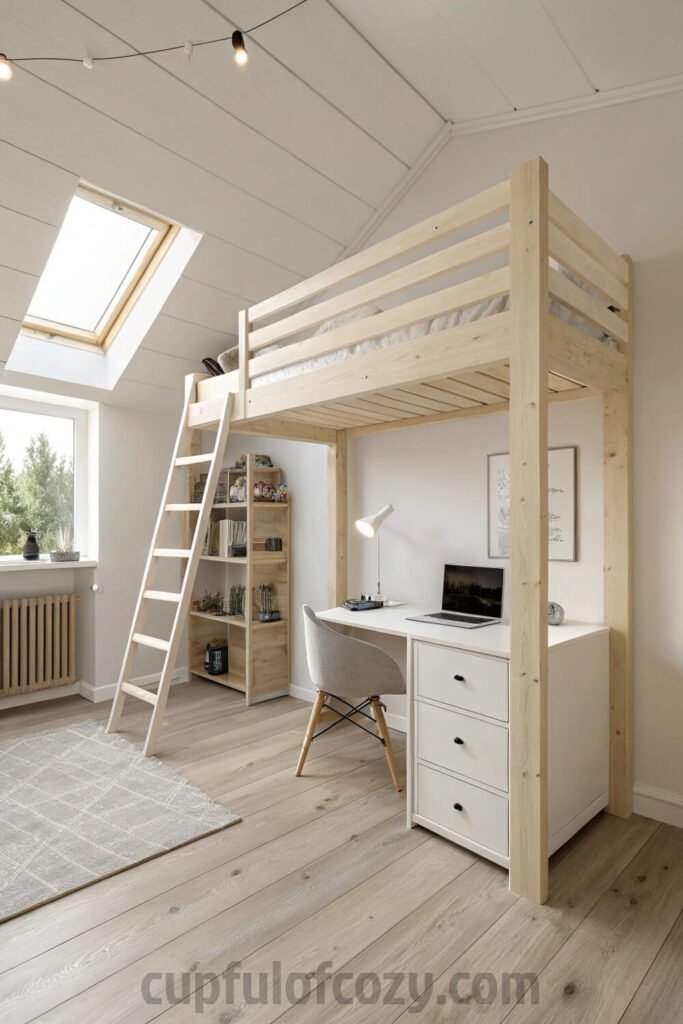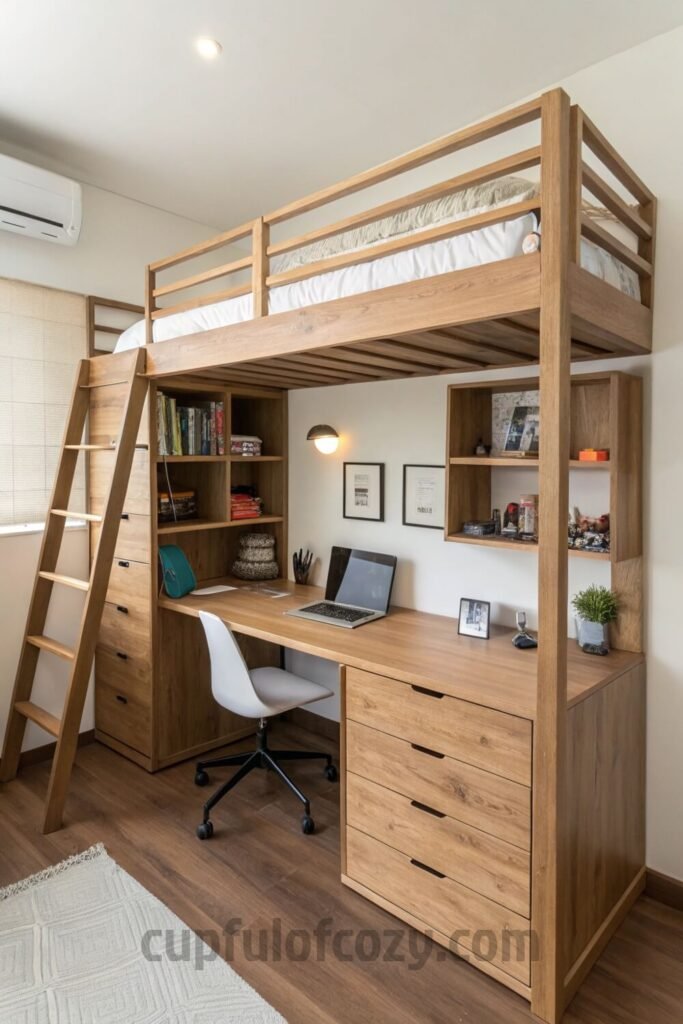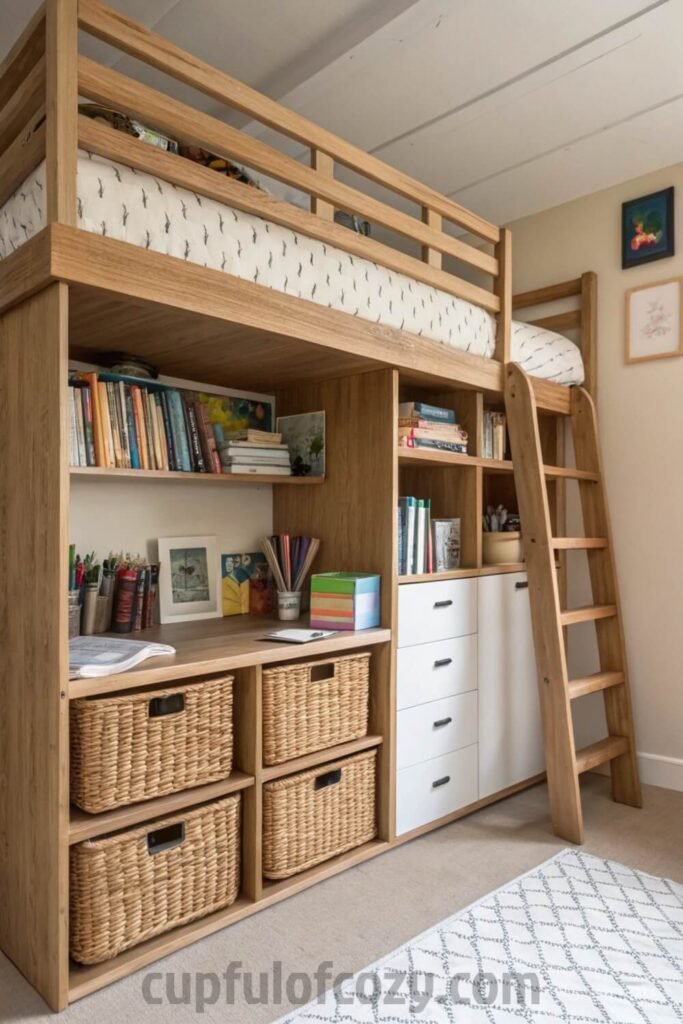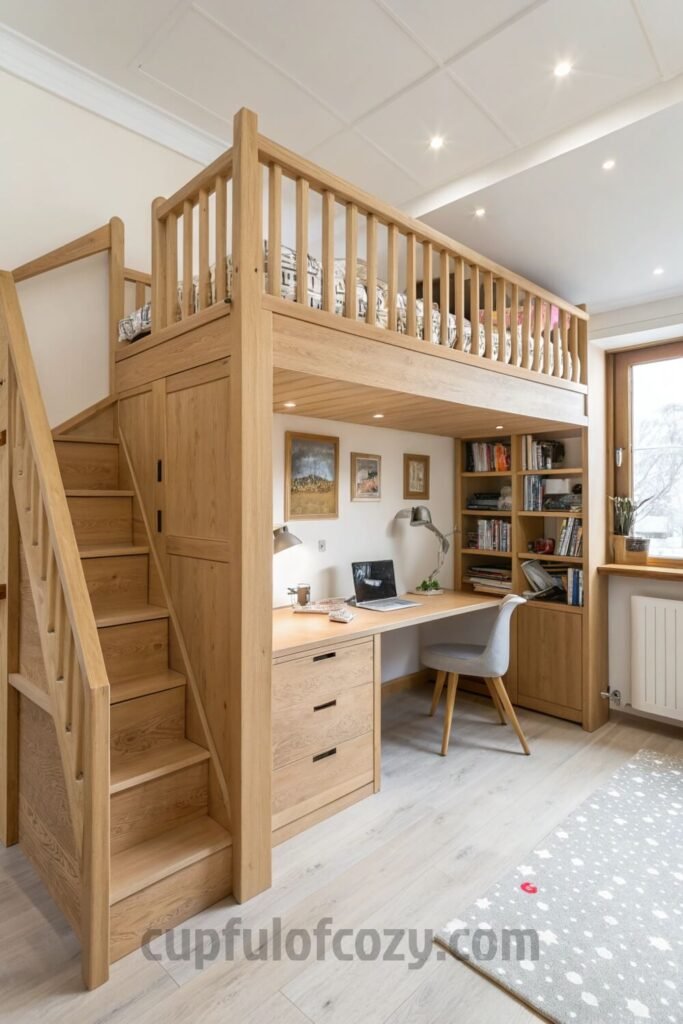So I’m sitting here in my tiny apartment, staring at this corner where I’ve been trying to squeeze a desk for literally months, and it hit me: I’ve been thinking about this all wrong. Last week I was doom-scrolling through apartment tours on TikTok (as one does at 2 AM), and I kept seeing these incredible loft bed setups where people had transformed the space underneath into these dreamy little study sanctuaries. Not gonna lie, I got a little obsessed.
Then my cousin Maya called me up, practically in tears because she’d just moved to this shoebox studio in Portland, and she couldn’t figure out where to put her desk without making the whole place feel like a storage unit. She’s in grad school, so having a proper study space isn’t optional. We were FaceTiming while she showed me around her place, and I’m looking at all this vertical space going to waste, and suddenly I’m like, “Girl, what about a loft bed?”
Fast forward two weeks, and she sends me this video tour of her space, and I swear I almost dropped my phone. She found this gorgeous reclaimed wood loft bed on Facebook Marketplace for $180 (I know, right?), and underneath she’d created this whole study nook that looked like something out of a boutique hotel. Warm lighting, plants everywhere, this vintage leather chair she thrifted, and suddenly her cramped studio felt like a grown-up sanctuary.
That got me thinking about my own space differently. I’ve been living in apartments for over a decade now, and I’m realizing how many of us just accept that small spaces mean compromise. But what if they didn’t have to? What if we could actually have more functionality and beauty, not less?
Here’s what I’ve learned from diving deep into the loft bed world: it’s not just about saving floor space (though that’s incredible). It’s about creating these intimate, cozy environments that make you actually want to sit down and get stuff done. There’s something about being in a slightly enclosed space that feels protective and focusing, like you’re in your own little world.
I’ve been researching and visiting friends who’ve done this, and I’m genuinely amazed by how creative people get with these setups. My friend Jen turned her space into this Scandinavian dream with all pale woods and clean lines. My neighbor Alex went full industrial with metal accents and Edison bulbs. And my coworker Sarah created this bohemian paradise with tapestries and string lights that makes me want to write poetry.
The best part? None of them spent more than $500 total to create these spaces, and most came in way under that. We’re talking thrift store finds, DIY solutions, and smart shopping at places like IKEA and Target. It’s proof that you don’t need a huge budget to completely transform how you live and work.
After spending way too much time taking notes and asking probably annoying amounts of questions, I’ve put together the best ideas I’ve seen. These aren’t just theoretical concepts, these are real setups from real people living in real small spaces, and they work. Whether you’re dealing with a studio apartment, a tiny bedroom, or you just want to maximize what you’ve got, here are nine ways to create a study space under a loft bed that’ll make you wonder why everyone isn’t doing this.
1. Cozy Wooden Cabin Vibes
My friend Emma lives in this converted warehouse apartment, and when she showed me her loft bed setup, I literally felt like I’d walked into the coziest mountain cabin. She’d leaned completely into the wood element of her bed frame and created this whole warm, rustic vibe underneath that makes you want to grab a mug of something hot and settle in for hours.
The genius was in how she played with the wood tones. Her loft bed was this beautiful light pine, so instead of fighting it, she found a matching desk at an estate sale and added these floating shelves in the same wood. But then she warmed everything up with richer accents: a walnut desk lamp, some darker wood picture frames, and this gorgeous vintage wooden chair with a woven seat that she reupholstered herself.
What really sold the cabin feeling was the lighting. She strung these warm Edison bulbs around the bed frame, not in that college dorm way, but more sophisticated, like accent lighting in a boutique. Then she added this brass desk lamp with a green glass shade that cast the most incredible warm glow. When she’s working there in the evening, it looks like something out of a cozy mystery novel.
The textures are what make it feel authentic though. She layered in this chunky wool rug, some linen cushions on her chair, and hung this beautiful woven wall hanging that her grandmother made. It’s not trying too hard to be rustic, it just feels naturally warm and inviting.
2. Scandinavian Minimalist Study Nook
Okay, so my sister Sarah has always been one of those people who gets anxious when there’s visual clutter around, and her approach to her loft bed space is so perfectly her. She went full Scandinavian minimalist, and walking into her room feels like stepping into one of those perfectly curated design blogs.
Everything is pale and purposeful. White desk, light birch wood, exactly three items on her desk at any given time. She has this rule that if it’s not being used, it doesn’t live on the surface, which sounds extreme but actually creates this incredibly peaceful environment. When I’m there studying, I swear I can think more clearly just because there’s nothing competing for my attention.
Her desk is this sleek IKEA piece that she mounted directly to the wall, so it almost floats beneath the bed. The chair is this simple wooden stool that slides completely underneath when not in use. She added one small floating shelf for her most essential books, and that’s it. The restraint is actually kind of beautiful.
The lighting is subtle but perfect: a slim LED strip along the edge of the bed frame provides ambient light, and she has this adjustable clamp light for focused work. No overhead lights, no dramatic fixtures, just clean, functional illumination that keeps the whole space feeling serene.
3. Built-in or Compact Desk Setup
When my roommate decided to get a loft bed, I watched her struggle for weeks trying to find a desk that would fit the space without looking weird or cramped. Then she had this brilliant idea to build a custom desk that followed the exact dimensions of the space underneath, and it completely changed everything.
She’s not particularly handy, but she found this local woodworker on Instagram who made her a simple L-shaped desk that fits perfectly against two walls under the bed. It has drawers built in for storage, and the whole thing cost less than a decent desk from West Elm. The result looks like it was always meant to be there, not like an afterthought squeezed into leftover space.
If custom isn’t in your budget, she also showed me some brilliant alternatives. There are these fold-down desks that mount to the wall and completely disappear when you’re not using them. Perfect if you want your space to transform from work mode to relaxation mode. And floating shelf desks can work surprisingly well if you don’t need a ton of storage.
The chair situation is crucial here too. You need something that can either slide completely under the desk or look good as part of the room when pushed aside. She went with this backless stool that tucks away perfectly, but a compact rolling chair can work too if you prefer back support.
4. Lighting to Brighten the Space
Here’s the thing about spaces under loft beds: they can either feel like cozy caves or actual caves, and lighting is what makes all the difference. I learned this the hard way when I first tried to work under my friend’s loft bed and could barely see my notebook.
The secret is layering different types of light sources. You need focused light for detailed work, ambient light to keep the space from feeling closed in, and maybe some accent lighting just because it makes everything more inviting. My cousin nailed this with her setup: she has a bright adjustable desk lamp for reading and writing, LED strip lights along the bed frame that provide gentle background illumination, and these small battery-powered puck lights mounted under floating shelves.
What I love about her approach is that everything is on different switches or dimmers. During the day when there’s natural light coming in, she might just use the desk lamp. In the evening, she can create this whole ambient lighting situation that makes the space feel warm and enclosed in the best way.
The placement matters too. Avoid casting shadows on your work surface, and try to bounce light off walls or the ceiling to create that soft, diffused glow that makes small spaces feel bigger rather than smaller.
5. Incorporate Storage Solutions
Storage in a loft bed study space is like a puzzle where every piece has to earn its place, and honestly, solving it is kind of satisfying. My friend Alex turned her under-bed area into this incredibly organized command center that makes me slightly jealous of how together her life looks.
She went vertical with floating shelves along one wall, but instead of just stacking books, she used a mix of open shelving and closed baskets so it doesn’t look cluttered. The baskets hide all the random stuff, supplies, cables, whatever, while the open shelves display her pretty books and plants. It’s functional but also looks intentional and styled.
Around the legs of her loft bed, she added these slim rolling carts that can slide in and out. One holds her printer and extra paper, another has all her art supplies organized in small containers. When she needs something, she rolls it out, uses it, rolls it back. When she doesn’t, the whole area looks clean and spacious.
Wall-mounted organizers are clutch here too. She has this pegboard system with hooks and small shelves that holds everything from headphones to coffee mugs to small plants. It keeps frequently used items within reach without taking up any floor or desk space.
6. Personal Touches for Comfort
This is where your study space goes from looking like a showroom to feeling like home. Personal touches are what make you want to actually spend time in a space instead of just enduring it. My coworker Maria has this incredible setup that feels like stepping into her personality.
She started with textures that make the space physically comfortable: a vintage Persian rug remnant under her desk that she found at a flea market, this incredible velvet desk chair that she reupholstered in deep green, and a chunky knit throw draped over the back of her chair for when she gets cold while working.
But what really makes it special are the personal details. She has a small gallery wall of family photos and art prints, some plants that she’s managed to keep alive (including this trailing pothos that drapes beautifully from a high shelf), and string lights that aren’t the college dorm kind but these warm, small bulbs that create the perfect ambiance.
She also has what she calls her “inspiration corner”: a small bulletin board where she pins quotes, photos, ticket stubs, anything that makes her happy or motivated. It changes regularly, so the space always feels fresh and personally meaningful.
7. Safety and Style with Railings
Safety doesn’t have to be boring, and the railings on your loft bed can actually add to the whole aesthetic instead of being an afterthought. I’ve seen some really creative approaches that make the railings part of the design story rather than just a necessary evil.
Wooden railings that match or complement your desk setup create this cohesive, intentional look. My friend’s setup has these beautiful horizontal slat railings in the same finish as her desk, and it ties everything together perfectly. Plus, the horizontal lines make the ceiling feel higher, which is a nice bonus in a smaller space.
Glass railings are another option that keeps the space feeling open and modern. They don’t block sightlines or make the area feel enclosed, which is especially important if your loft bed is in a studio or open floor plan situation.
Some railing designs even incorporate functionality: little ledges where you can display small plants or keep your coffee mug while you work, or integrated lighting that adds both safety and ambiance. It’s like getting built-in styling that doesn’t eat up any of your precious desk space.
8. Multi-Function Space
Why limit yourself to just studying when you could create a whole little world under there? The most successful loft bed spaces I’ve seen are the ones that serve multiple purposes, making them places people actually want to spend time rather than just work stations they tolerate.
My friend Kate created this incredible combo space that works as a study area during the day and transforms into a cozy reading nook in the evening. She has her desk along one wall, but in the corner there’s this comfortable reading chair with good lighting and a small side table for tea or wine. The same space serves double duty without feeling cramped or confused.
The key is choosing furniture and décor that works for multiple functions. String lights provide ambient lighting for both studying and relaxing. A comfortable chair works for both computer work and reading. Plants and personal touches make the space inviting whether you’re being productive or just hanging out.
This approach also maximizes your investment. Instead of having a study space you only use when you have work to do, you have a retreat you can enjoy throughout the day. It becomes a destination within your home rather than just a functional corner.
9. Use of Neutral and Soft Tones
There’s something so calming about a neutral color palette, especially in a study space where you want to minimize distractions and create a sense of peace. I used to think neutral meant boring, but after spending time in several of these thoughtfully designed spaces, I completely understand the appeal.
Sticking with whites, beiges, soft grays, and natural wood tones creates this serene backdrop that makes small spaces feel bigger and brighter. It’s also forgiving when it comes to clutter or personal items that might not match perfectly. Everything just seems to work together naturally.
My friend’s all-neutral space feels incredibly sophisticated and grown-up. She uses white for the walls and main furniture pieces, adds warmth with natural wood accents, and introduces texture through things like a jute rug, linen curtains, and woven baskets. The result is calming but not sterile, cozy but not cluttered.
The practical benefit is flexibility. With a neutral backdrop, you can switch up your décor seasonally or as your taste evolves without having to repaint or replace major furniture. Swap out throw pillows, change your desk accessories, add different plants or artwork, and suddenly you have a completely different vibe without the major overhaul.
Final Thoughts
Creating a study space under a loft bed is honestly one of those ideas that sounds simple but can completely change how you experience your home. It’s not just about saving space, though that’s certainly a benefit. It’s about creating intentional environments that support how you want to live and work.
What I love most about these setups is how personal they become. Unlike a kitchen or bathroom that has to function in pretty standard ways, a study nook can be completely tailored to your needs, your aesthetic, your way of working. Whether you need bright light and clean surfaces or warm ambiance and lots of storage, the space under a loft bed gives you this blank canvas to create exactly what works for you.
Plus, there’s something deeply satisfying about maximizing space in creative ways. It feels resourceful and intentional, like you’re getting the most out of what you have instead of just wishing you had more. In a world where housing costs keep climbing and spaces keep shrinking, that feels pretty empowering.
Related posts:
10 Cute Loft Bed and Desk Underneath Inspiration for Shared Sibling Rooms
20 Cozy Luxury Bedroom Ideas That Feel Like a 5-Star Retreat (Instantly Elevate Your Space)
The $5 Trick to Make Any Christmas Tree Look Fuller
11 Budget-friendly Festive Christmas Hot Chocolate Station Ideas to Impress Your Guests
- Before buying anything online, check Rakuten (formerly Ebates) — either with the browser extension or directly on Rakuten.com. Just type in your store, click the current deal, and shop as usual. Every purchase earns you cashback that can be mailed to you or sent via PayPal. In today’s economy, even a few dollars back can turn into a Starbucks latte, McDonald’s fries for the kids, or a little treat you don’t have to budget for. If you’ve never used Rakuten before, you’re missing out on free money — and right now, you’ll even get a $30 bonus when you spend your first $30. Click here to sign up and stop letting your online orders steal from you. Click here to sign up and save money!
*Disclosure: This post includes affiliate links. I may earn a small commission if you join Rakuten through my link — but it doesn’t cost you anything extra. In fact, you’ll actually save more!

